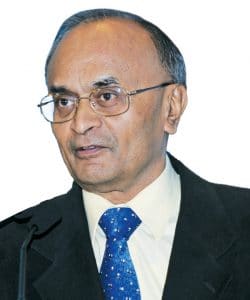 Manufacturers in the aerospace and defence (A&D) sector have been major participants in the technological transition brought about by Industry 4.0. In a conversation with Baishakhi Dutta, senior business journalist at Electronics Bazaar, M.N. Vidyashankar, president, India Electronics and Semiconductor Association (IESA), shares his views on the role of IoT in the Indian aerospace and defence manufacturing industry.
Manufacturers in the aerospace and defence (A&D) sector have been major participants in the technological transition brought about by Industry 4.0. In a conversation with Baishakhi Dutta, senior business journalist at Electronics Bazaar, M.N. Vidyashankar, president, India Electronics and Semiconductor Association (IESA), shares his views on the role of IoT in the Indian aerospace and defence manufacturing industry.
EB: Tell us a little about the market scenario for aerospace and defence manufacturing in India.
The opportunities for electronics manufacturing in India span both standalone systems as well as sub-systems. The total market potential for the A&D (aerospace and defence) electronics sector in India will reach US$ 70-72 billion in the next 10-12 years. Of this, almost US$ 53-54 billion will be spent on platforms (i.e., at the Tier 1 and Tier 2 levels). Another US$ 17-18 billion will be for what is traditionally called system-of-system projects like the Indian Army’s Project TCS (Tactical Communication System) and Project BMS (Battlefield Management System).
EB: Please enlighten us about the latest technology trends in the Indian A&D sector.
Between 2007 and 2012, more than US$ 50 billion were spent on new equipment for the Indian defence sector. Current modernisation plans will accelerate spending by over US$ 200 billion on procurements planned for between 2013 and 2022 in India. Commercial applications will become more important and take over the role of technology drivers. Indian companies and global OEMs will continue to explore models of collaboration, focusing on developing capabilities in India and on technology tie-ups.
EB: How much has IoT penetrated into the Indian A&D manufacturing scenario?
IoT has been playing a significant role in the A&D sector since a while, in terms of implementing sensors and in computerised automation. The process of networks of devices operating on the basis of machine-to-machine (M2M) interactions, without human intervention, has been adopted by the A&D industry a long time back. However, in the case of the manufacturing scenario in India, IoT will take some time to be adopted.
EB: What are the current IoT security standards in the A&D sector and is there scope for improvement?
IoT faces a number of challenges in terms of security standards. Presently, the biggest problem with IoT is the lack of consistent standards. This can complicate product development and the industry’s growth, apart from posing a security threat. Uniform standards and appropriate certificates would eliminate this major challenge.
EB: What are the challenges that A&D manufacturers face in incorporating IoT?
One of the major challenges is the cost of adopting the technology. Incorporating IoT outright can be an expensive venture for large manufacturing companies. Small ones may not be able to sustain the cost. The other major challenges are a lack of standards and security, the absence of the right skillsets and limited availability of experienced manpower to adopt the new technology.
EB: What is the roadmap for the A&D manufacturing sector in light of the evolution of connected manufacturing?
A&D companies have been successfully implementing sensors and using computerised automation for decades in their manufacturing operations. IoT will redefine not only manufacturing processes, but also the look and feel of a product. It will reduce global competitiveness with increased co-location of design, manufacturing and services. IoT in A&D is not a very distant concept —it will be implemented within a few years.





























